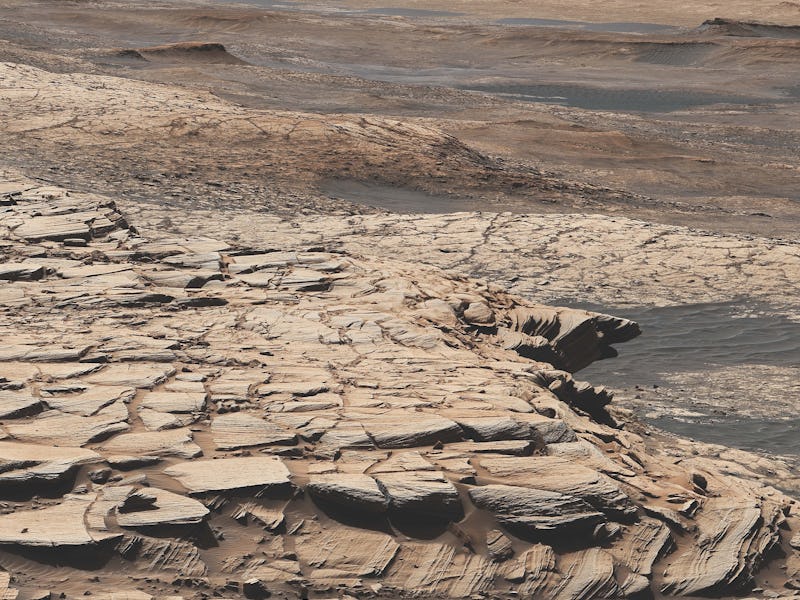Curiosity finds “intriguing carbon signatures” on Mars
One potential culprit? Ancient Martian microbes.

Since landing on Mars, NASA’s Curiosity rover has been racking up novel Martian discoveries. But its newest one could end up being a holy grail of planetary discoveries.
The car-sized robot recently detected a carbon signature in rock samples from Mars’ surface. That same signature is associated with biological processes on Earth and could indicate some form of life on the Red Planet.
But before calling it a signature of life, scientists are trying to understand what else may have been behind the carbon on Mars. Mounting evidence suggests that Mars may have been habitable at some point during its early past, with water on its surface and warmer temperatures.
The findings are detailed in a study published Tuesday in the Proceedings of the National Academy of Sciences.
Several missions have investigated Mars in search of signs of ancient microbial life. But scientists have not claimed life on Mars yet, and are still waiting for definitive evidence to say that there is indeed life beyond Earth.
“We’re finding things on Mars that are tantalizingly interesting, but we would really need more evidence to say we’ve identified life,” Paul Mahaffy, the principal investigator of the Sample Analysis at Mars (SAM) chemistry lab on the Curiosity rover, said in a statement. “So we’re looking at what else could have caused the carbon signature we’re seeing, if not life.”
WHAT’S NEW — Curiosity has analyzed powdered rock samples from Mars’ Gale Crater throughout its mission.
NASA’s Curiosity rover drilled a hole on Mars’ Gale Crater, and the powder from this hole was enriched in carbon-12.
The rover then used the Tunable Laser Spectrometer (TLS) instrument inside the SAM lab to analyze the samples. The scientists behind the mission heated the samples to about 1,500 degrees Fahrenheit to release the gases inside.
They then measured the isotopes from the samples and found signatures of carbon. Nearly half of the samples had surprisingly large amounts of carbon-12 compared to the carbon found in Mars’ atmosphere. On Earth, carbon is found in all life. Living things on Earth use carbon-12 atoms to metabolize food or for photosynthesis.
“There’s a huge chunk of the carbon cycle on Earth that involves life, and because of life, there is a chunk of the carbon cycle on Earth we can’t understand, because everywhere we look there is life,” Andrew Steele, a Curiosity scientist based at the Carnegie Institution for Science in Washington, D.C., said in a statement.
WHERE DID THE CARBON COME FROM? — The scientists behind the discovery are investigating three different scenarios that may be responsible for the carbon.
3. The first scenario suggests the carbon may result from ultraviolet light interacting with carbon dioxide gas in Mars’ atmosphere, producing new carbon-containing molecules that later settled to the surface of the planet.
2. Meanwhile, a second scenario suggests that at some point during its early history, about a hundred million years ago, the Solar System passed through a giant molecular cloud rich in the type of carbon found on Mars’ surface.
1. And finally, the third scenario suggests life. Scientists believe that ancient bacteria-like organisms could have released methane into the atmosphere where ultraviolet light would have converted that gas into larger, more complex molecules.
The new molecules would have rained down to the surface and preserved their distinct carbon signature in Martian rocks.
“All three explanations fit the data,” Christopher House, a Curiosity scientist based at Penn State, and lead author of the study, said in a statement. “We simply need more data to rule them in or out.”
WHAT’S NEXT — Scientists are still trying to understand the carbon cycle on Mars.
NASA’s Curiosity rover landed on Gale Crater on August 6, 2012, and has been roaming the Martian terrain ever since.
The Curiosity rover will continue to measure carbon isotopes on different sites that may also have well-preserved rock to see if there are similar signatures elsewhere on Mars.
Curiosity’s findings will also help its successor Perseverance, which landed on Mars in February 2021, search for Martian samples to collect.
“Defining the carbon cycle on Mars is absolutely key to trying to understand how life could fit into that cycle,” Steele said. “We have done that really successfully on Earth, but we are just beginning to define that cycle for Mars.”
This article was originally published on